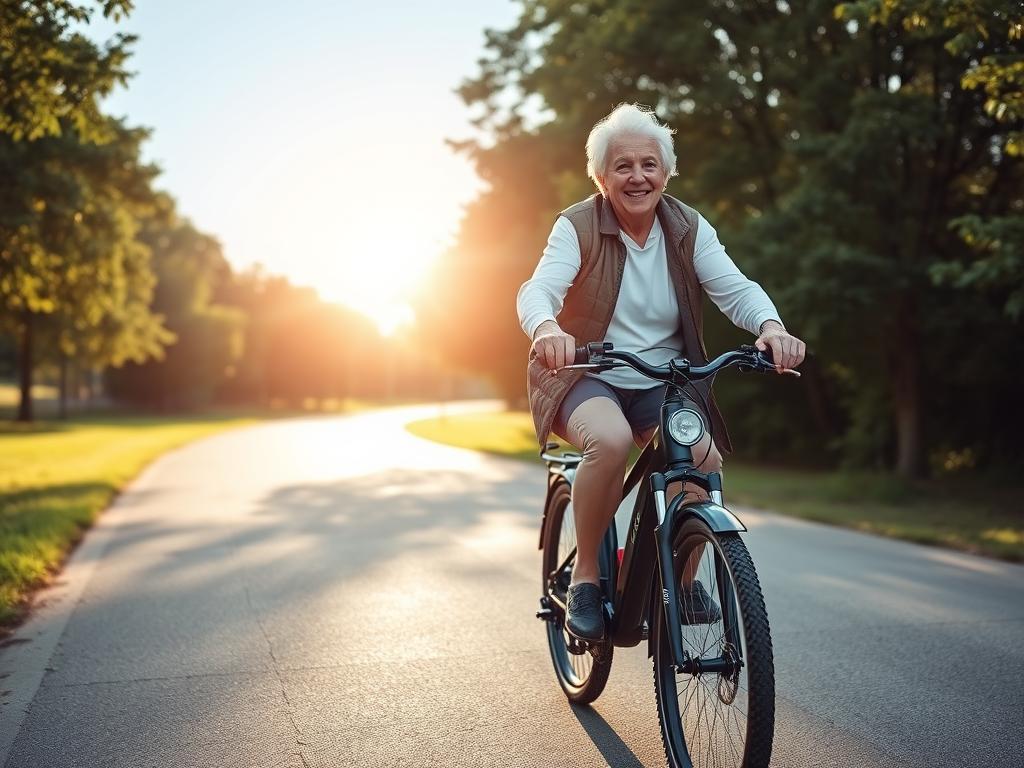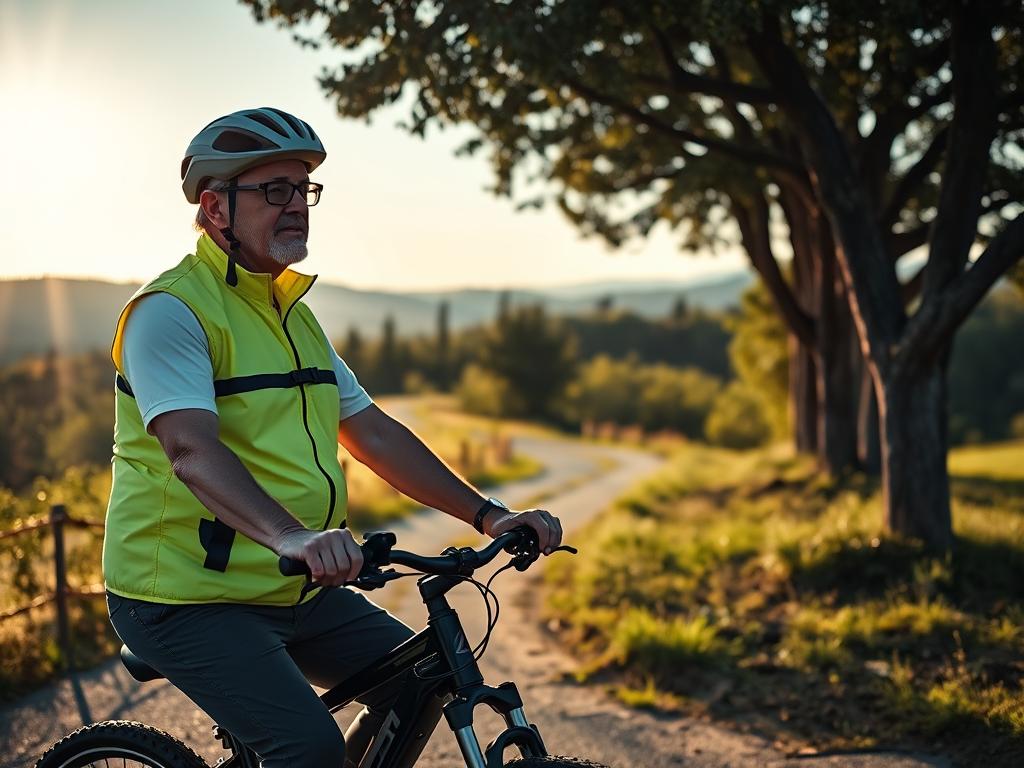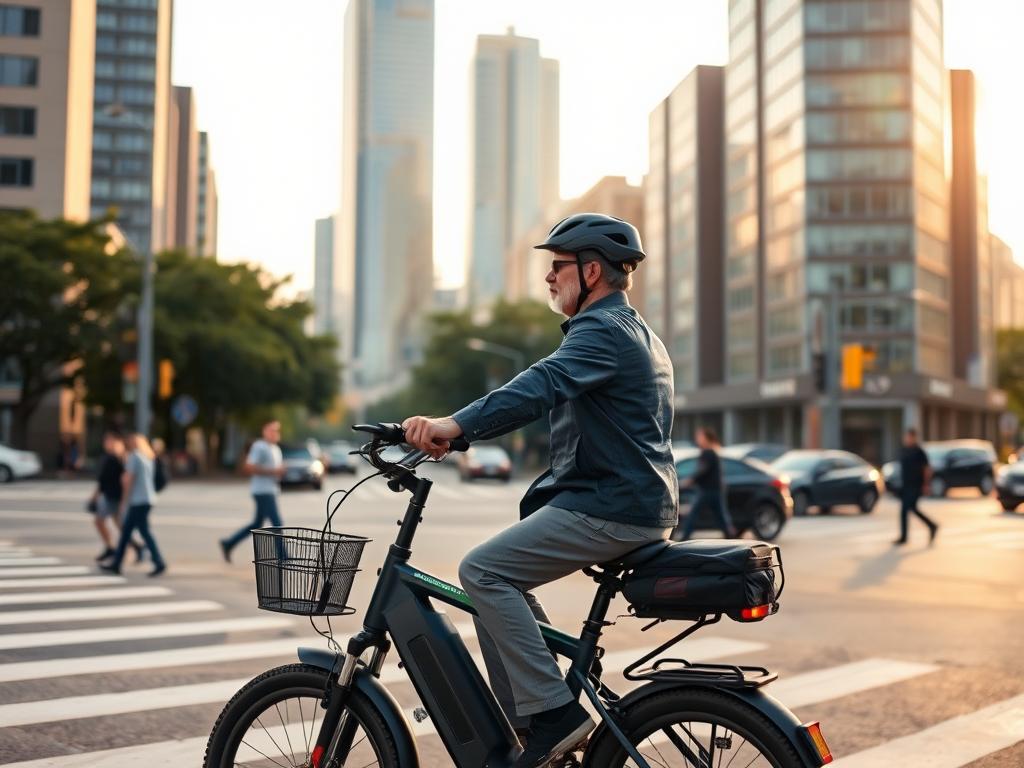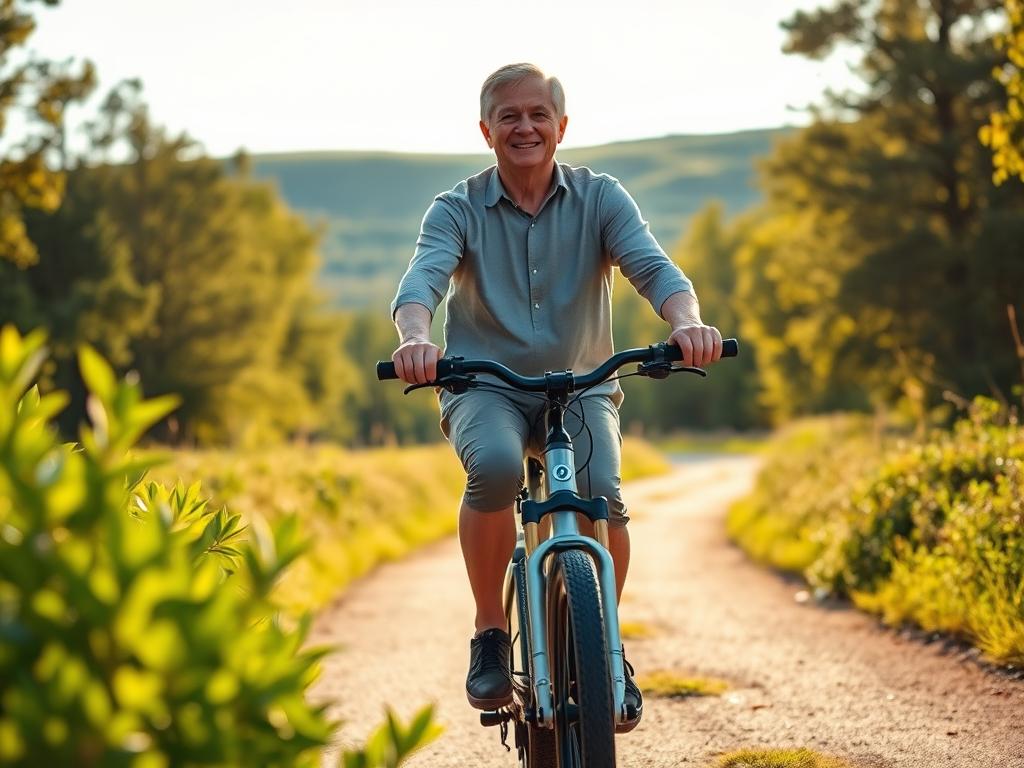As we get older, staying active is more important than ever. E-bike Exercise Programs for Seniors have made cycling fun. They help you ride over tough terrain while keeping you fit.
Electric bicycle workouts are becoming more popular among older Americans. At ebikesus.com, we’ve seen many people find joy in riding again. They’ve discovered the fun of moving around outdoors with the help of electric bikes.
Staying active is key to staying healthy and avoiding injuries. Cycling with electric help is great because you can choose how hard you want to work. Yet, you still get to enjoy the benefits of moving around.
This guide will show you how cycling can boost senior fitness. We’ll talk about safety, workouts, and picking the right bike for your active aging journey.
Table of Contents
Key Takeaways
- Electric bicycles make cycling accessible for older adults by providing assistance when needed
- Regular cycling helps maintain health and reduces risk of heart disease
- Pedal-assist technology allows you to control your exertion level
- Proper equipment selection is crucial for comfort and safety
- Structured riding programs can significantly improve mobility and independence
- Cycling communities offer social benefits alongside physical activity
Understanding the Benefits of E-bike Exercise Programs for Seniors
E-bikes have opened new doors for seniors to stay active and connected. They are easy to use and offer a mix of exercise and support. This makes them perfect for older adults.

E-bikes from places like EBikesUS.com have motors that help with pedaling. This makes it easier to ride without losing the health benefits. Many seniors who thought they couldn’t cycle anymore are now enjoying e-bikes.
Maintaining Independence and Mobility
For older adults, staying independent is key. E-bikes are a great way to get around without driving a car. They’re especially helpful for those who don’t drive or prefer not to.
E-bikes let you go places that walking might not. You can run errands, visit friends, or go to appointments on your own. This independence boosts your quality of life and happiness.
The pedal-assist feature helps you tackle hills and headwinds. You can adjust how much help you get, making rides fit your energy and route.
Low-Impact Exercise and Health Advantages
Finding good exercise can be tough for seniors. E-biking is a low-impact cardio option that’s easy on the joints. It’s great for staying fit without the stress of high-impact activities.
Studies show e-biking is good for older adults’ health. A study in the Journal of Transport & Health found it’s a moderate-intensity workout. This improves heart health and lowers disease risk.
Other health benefits include:
- Improved balance and coordination
- Enhanced muscle strength, particularly in the lower body
- Better blood sugar control
- Reduced stress and anxiety
- Improved cognitive function
E-biking works your muscles and heart, even with help from the motor. You can start slow and get fitter by using less assistance.
Rediscovering the Joy of Cycling
Many seniors have fond memories of cycling. E-bikes let you relive that joy without the old challenges. The motor helps you overcome obstacles that used to stop you.
With an e-bike, you can keep up with younger family or friends. This makes it easier to share activities and bond across age gaps.
Riding an e-bike feels like cycling again, but better. It’s more comfortable and lets you enjoy the wind in your hair. Many seniors feel younger and freer when they ride.
Social Engagement and Community Connection
Cycling is great for seniors because it’s social. E-biking connects you with others, whether in group rides or just out on the path.
Many places have e-bike groups for seniors. These groups offer:
- Structured social interaction
- Safety in numbers
- Motivation to ride regularly
- Opportunities to explore new routes
Group rides help fight loneliness and depression, common in older adults. They create new friendships and a sense of community.
E-biking also lets you see your neighborhood in a new way. At cycling speed, you notice things you miss driving. This deepens your connection to your community.
“E-biking has transformed my retirement. I ride three times a week with friends from the senior center, and I’ve never felt healthier or more connected to my community. The pedal assist gives me just enough help to keep up and enjoy the experience without exhaustion.”
E-biking is great for seniors because it’s active, independent, fun, and social. It’s a versatile way to improve your health and wellbeing.
Choosing the Perfect Senior-Friendly E-bike
Choosing an e-bike as a senior rider means looking for age-friendly features. These features help you feel confident and independent. The right e-bike can make your daily routine fun and support your mobility needs. With many options at retailers like ebikesus.com, knowing what makes an e-bike senior-friendly is key.
Key Features to Look For
When shopping for an e-bike, certain features are crucial. Step-through frames make it easy to get on and off the bike. This design helps prevent falls and makes mounting and dismounting simple.
An upright riding position is also important. It reduces strain on your neck, shoulders, and wrists. Look for models with adjustable handlebars for a comfortable riding position.
Many seniors prefer e-bikes with wider, cushioned seats for longer rides. Some models even have suspension seatposts to smooth out rough roads.
Intuitive controls with large displays are great for senior riders. These displays should clearly show battery level, speed, and assist mode. Some e-bikes have simple controls designed for older adults.
Also, consider the overall weight of the e-bike. Electric bicycles are heavier than traditional bikes. But some models are designed to be lighter, making them easier to handle.
Understanding E-bike Motors and Assist Levels for Seniors
E-bikes have different motor types, each with its own benefits for seniors. Hub motors are in the front or rear wheel and offer a straightforward ride. They’re easy to maintain and reliable for casual riding.
Mid-drive motors are at the bike’s center and provide better balance. They’re great for seniors who ride on varied terrain, as they work well with the bike’s gears.
Understanding assist levels is key for a good exercise routine. Most e-bikes have multiple levels of pedal assistance:
- Eco/Low: Provides minimal assistance, ideal for gentle exercise and maximizing battery life
- Normal/Medium: Offers balanced support for everyday riding
- High/Turbo: Delivers maximum assistance for challenging hills or when fatigue sets in
As a senior rider, having these options lets you adjust your effort based on your energy and health. The pedal-assist feature ensures you get exercise while feeling supported.
Importance of Proper Fit and Adjustments
A proper fit is crucial for comfort and safety. E-bikes have extra components that affect fit. Make sure your feet can touch the ground when seated.
Handlebar height and reach should allow for an upright posture. Your arms should be slightly bent, and you shouldn’t feel strain in your shoulders or lower back.
The saddle position is also important. Adjust the height so your leg extends with a slight bend at the lowest pedal point. The saddle should be level or slightly tilted downward for comfort.
Many senior-friendly e-bikes have adjustable stems for handlebar position without tools. This flexibility is valuable as your comfort needs may change over time or during longer rides.
Considering Range and Battery Life for Typical Senior Rides
Battery performance is key for senior e-bike riders. Most quality e-bikes offer ranges between 20-80 miles per charge. Consider your typical riding patterns when evaluating battery needs.
For short trips or local errands, a smaller battery might suffice. But for longer rides or hilly areas, a larger capacity battery is better.
Removable batteries are especially beneficial for senior riders. They let you charge the battery indoors without moving the bike, which is helpful in apartments or homes without garage access.
Also, consider battery charging time. Most e-bike batteries take 3-6 hours to fully charge. Some models offer fast-charging or the option to buy a second battery for longer range.
When shopping at retailers like ebikesus.com, ask about battery warranty and replacement costs. A quality battery should last 500-1000 charge cycles, making your e-bike a sustainable mobility aid for active aging.
Essential Safety Gear and Pre-Ride Checks for Seniors
For seniors starting e-biking, knowing safety basics is key. E-bikes are great for staying active and independent. But, it’s important to follow safety tips to avoid injuries and have fun.
Must-Have Safety Equipment
Safety gear is a must for e-bike riders, especially seniors. The right gear keeps you safe and visible to others.
Helmets are non-negotiable for e-bike riders. Choose helmets made for e-biking, which cover more of your head. Make sure your helmet fits right—it should sit level and not move.

Visibility is crucial, especially at dawn, dusk, or night. Wear bright, reflective clothes and use lights on your e-bike. The front light should light your path, and the rear light should make you visible to traffic.
Other gear to consider includes:
- Cycling gloves for better grip and hand protection
- Eyewear to shield against sun, wind, and debris
- Elbow and knee pads for extra protection, especially for those with balance concerns
- Rearview mirrors for better awareness
Comfortable and Appropriate Attire for E-biking
The right clothes make e-biking safer and more fun. E-biking is less tiring than traditional cycling, so your clothes might be different.
Wear breathable, moisture-wicking fabrics that keep you comfy in various weather. Layering is key, especially for seniors who feel temperature changes more. A lightweight, water-resistant jacket is handy.
Proper footwear is crucial for safe e-biking. Choose closed-toe shoes with good grip and rigid soles. Avoid loose laces that could get caught in the chain or pedals.
For longer rides, padded cycling shorts or underwear can make a big difference. They support muscle strengthening and prevent discomfort.
Simple Pre-Ride E-bike Inspection Checklist
Checking your e-bike before each ride is important. It prevents mechanical issues and ensures a safe ride. This quick check takes just a few minutes.
| Component | What to Check | Why It Matters | How Often |
|---|---|---|---|
| Battery | Charge level, secure attachment | Prevents unexpected power loss | Before every ride |
| Tires | Pressure, wear, debris | Ensures stability and prevents flats | Before every ride |
| Brakes | Responsiveness, pad wear | Critical for stopping safely | Before every ride |
| Lights & Reflectors | Function, visibility | Ensures you’re seen by others | Before evening rides |
| Quick-release levers | Proper closure, tightness | Prevents component failure | Weekly |
Brakes are your main safety feature. Test both front and rear brakes while standing beside your bike. They should engage smoothly without touching the handlebars. If you hear grinding sounds or notice delayed response, get your brakes checked before riding.
For seniors using e-biking for balance training, keeping your bike in good shape is crucial. A well-maintained e-bike ensures predictable handling, builds confidence, and supports balance improvement.
Understanding Local E-bike Laws and Regulations
E-bike laws vary across the United States. It’s important to know the rules in your area. Most states classify e-bikes into three categories:
- Class 1: Pedal-assist only (no throttle), with assistance stopping at 20 mph
- Class 2: Throttle-assisted, with a maximum speed of 20 mph
- Class 3: Pedal-assist only, with assistance stopping at 28 mph
These classifications determine where you can legally ride your e-bike. Class 1 and 2 e-bikes are often allowed on bike paths and trails. Class 3 e-bikes may be restricted to roads and bike lanes. Some national parks and state recreation areas have their own rules for e-bike access.
Check with your local transportation department or bicycle advocacy groups for the latest information. Websites like EbikesUS offer resources on state-specific e-bike laws and help you navigate the rules.
Knowing these regulations keeps you legal and helps plan safe routes for your golden years. Many seniors find that understanding the rules boosts their confidence and enjoyment of e-biking.
By focusing on safety through proper equipment, attire, maintenance, and knowledge of local regulations, you’re setting yourself up for years of enjoyable e-biking. These precautions let you enjoy the health benefits and simple pleasures of exploring your community on two wheels.
Planning Safe and Enjoyable E-bike Routes
For seniors who love e-biking, picking the right route is key. It turns a simple ride into a fun adventure while keeping safety first. The best route is scenic, easy to navigate, and has all the amenities you need.
Let’s look at how to plan e-bike trips that are fun and safe for older riders.
Identifying Low-Traffic and Dedicated Bike Paths
When planning e-bike routes, safety should be your main focus. Luckily, many places in the U.S. have bike paths just for cyclists.Dedicated bike paths are the safest for senior e-bikers. They keep you away from cars, making rides less stressful.
Many cities have built lots of protected bike lanes and paths.
Rail trails are great for senior e-bikers too. These paths used to be railroad tracks but are now for fun. They’re usually:
- Gentle grades (railroads couldn’t handle steep inclines)
- Wide, well-maintained surfaces
- Scenic routes through natural areas and small towns
- Limited road crossings
Neighborhood greenways and bike boulevards are other good choices. These are streets in residential areas made for bikes. They have features that slow down cars but let bikes flow smoothly.
The beauty of e-biking for seniors is that it opens up a whole new world of exploration. With proper route planning, riders can safely enjoy the freedom of cycling well into their golden years.
Utilizing Online Tools and Apps for Route Mapping
Technology makes planning routes easy. There are many digital tools to help find and map senior-friendly e-bike routes.

- Ride with GPS – Allows filtering routes by elevation gain and surface type
- Strava – Features heat maps showing popular cycling routes
- Google Maps – Offers bicycle-specific directions and highlights dedicated bike paths
- TrailLink – Specializes in rail trails and other dedicated paths
- Komoot – Provides detailed terrain information and difficulty ratings
When using these tools, look for routes tagged as “easy” or “beginner-friendly.” Many apps let you filter routes by distance, elevation gain, and surface type. These are important for senior riders.
Some communities also publish local bike maps with senior-friendly routes. Check with your local parks department, senior center, or bicycle advocacy group for these resources.
Factoring in Rest Stops and Accessibility
Even with an e-bike motor, it’s good to plan for breaks. When mapping your route, find places to rest, refresh, and recharge—both yourself and your e-bike.
Consider these factors when planning rest stops:
- Availability of public restrooms
- Benches or seating areas
- Access to drinking water
- Shade during hot weather
- Shelter options in case of sudden weather changes
- Proximity to food options
Battery life is key for longer rides. Modern e-bikes have great range, but seniors might need more power. This can drain batteries faster. Plan routes with charging spots if you’ll be riding far.
Many parks, cafes, and visitor centers offer outlets for charging. Websites like EBikesUS.com give info on battery range for senior riders.
Assessing Terrain and Elevation for Senior Riders
Not all bike routes are the same in terms of difficulty. For senior e-bikers, knowing the terrain and elevation is crucial for a comfortable ride.
| Terrain Type | Advantages | Considerations | Best For |
|---|---|---|---|
| Flat Rail Trails | Minimal effort, predictable surface | May lack shade in some areas | Beginners, those with joint issues |
| Gentle Rolling Hills | More interesting views, moderate challenge | Requires strategic use of assist levels | Intermediate riders seeking variety |
| Urban Greenways | Access to amenities, well-maintained | Potential for pedestrian traffic | Riders who want convenience |
| Coastal Paths | Scenic views, typically flat | Wind exposure, sand hazards | Those seeking inspiring landscapes |
| Forest Trails | Shade, natural beauty, protection from wind | May have roots or uneven surfaces | Nature lovers with wider tires |
When checking out routes, watch for:
Elevation gain– Even with e-assist, steep hills can be tough. Look for routes with gradual climbs. Most mapping apps show elevation profiles to help you see the climbs.
Surface quality– Smooth, paved surfaces are easier on joints and need less focus. Rough or loose surfaces may require more skill.
Distance between bailout points– Think about where you could stop if needed. Routes with many access points give you flexibility if you need to cut a ride short.
E-bikes let you adjust assist levels based on terrain. Increase assist on hills for an easier ride. On flat sections or downhills, reduce assistance to save battery and get more exercise.
For seniors new to e-biking, start with short, flat routes near home. As you get more confident and fit, try more varied terrain. Many senior cycling programs start with easy paths and add more challenging routes as you get better.
The perfect route balances challenge with fun. E-biking isn’t about exhausting yourself but enjoying the ride with just the right effort.
By planning routes that match your abilities and likes, you’ll create enjoyable and sustainable e-biking routines. The right route turns a simple bike ride into a fulfilling outdoor adventure that’s good for your body and mind.
Mastering Urban E-biking: Essential Tips for Seniors
Urban e-biking is a great way for seniors to stay active. It’s a low-impact workout that helps with mobility. Riding in the city can be fun and safe with the right skills.
Modern e-bikes have features that help seniors feel safe in the city. They have good brakes and adjustable assist levels. These features help you feel confident on busy streets.
Navigating Intersections and Traffic Signals Confidently
Intersections can be scary for senior e-bikers. But, with the right techniques, you can ride safely. Stay in the center of your lane at traffic lights.
Make eye contact with drivers. This shows they see you and helps avoid accidents. Also, position yourself ahead of stopped cars at red lights.

Learn the traffic signal patterns in your area. Some cities have special signals for bikes. Know where to position your e-bike for bike detection systems.
- Use hand signals 100 feet before turning
- Position yourself in the appropriate lane early
- Avoid stopping in blind spots of larger vehicles
- Wait for a full green light rather than rushing yellow signals
Tips for Riding in Areas with Pedestrians
When riding with pedestrians, be polite and aware. Always slow down in areas with foot traffic. Your e-bike’s power assist can make you go too fast, so ride like you’re walking.
Announce your presence when passing pedestrians from behind. Say “Passing on your left” to warn them. Give them at least three feet of space, more if you can.
In crowded areas, consider walking your e-bike. This shows respect and avoids accidents. Remember, pedestrians always have the right of way.
Strategies for Dealing with Road Hazards
City streets have hazards like potholes and uneven pavement. Look ahead 20-30 feet to spot these. This helps you avoid them.
For small obstacles, stand on the pedals with bent knees. This lets your bike roll over them while you stay stable. E-bikes with larger tires also help with stability.
Be careful of:
- Parallel drainage grates that can trap thin tires
- Wet metal surfaces like manhole covers that become slippery
- Debris in bike lanes, particularly after storms
- Trolley or railroad tracks that should be crossed at right angles
Many senior-friendly e-bikes have suspension systems. These systems make riding over rough streets more comfortable.
Using Your E-bike’s Bell and Signals Effectively
Clear communication is key for safe riding. Use your e-bike’s bell or horn to alert pedestrians. Don’t startle them.
Hand signals are important for talking to drivers. Use them to signal turns and stops. Practice these signals in a safe place.
When signaling, keep one hand on the handlebars. Signal early so others can react. Some e-bikes have turn signals and brake lights for extra safety.
With these tips, seniors can enjoy e-biking in the city. Each ride helps you get better and more confident.
Health and Comfort Considerations for Senior E-bikers
For seniors, it’s key to focus on health and comfort when e-biking. E-biking is a great way to get some low-impact cardio for retirees. It’s fun and helps you stay fit, thanks to adjustable levels of help. But, it’s important to know how to stay safe and healthy while enjoying it.
Consulting with a Doctor Before Starting
Talking to your doctor is the first step in starting your e-biking journey. This is crucial if you have health issues like heart disease or arthritis.
At your doctor’s visit, share your plans to start e-biking. They can give advice based on your health history. They might suggest limits on how long or hard you should ride to stay safe.
Doctors often recommend e-biking for seniors. It’s good for your heart and is easier on your joints than many other exercises. Ask your doctor about any concerns with your medications or health conditions.
Pacing Yourself and Listening to Your Body
E-bikes let you control how hard you work out. Modern e-bikes have easy controls to adjust the help you get.
Start with short rides and gradually go longer as you get fitter. Watch how your body feels during and after rides. If you feel sharp pain or get really out of breath, slow down or stop.

The pedal-assist feature lets you challenge yourself when you’re feeling up to it. It also helps when you’re tired. This makes e-biking great for adapting to your energy levels.
Staying Hydrated and Energized on Rides
Staying hydrated is crucial for all riders, but seniors need to be extra careful. Dehydration can make it harder to balance and judge your surroundings safely.
Always carry water and drink it often, even if you don’t feel thirsty. For longer rides, bring a snack to keep your blood sugar steady.
Choose routes with places to get water. Some seniors find it helpful to use hydration backpacks or water bottle holders on their handlebars.
“I started e-biking at 72 and discovered that staying properly hydrated made a tremendous difference in my endurance and how I felt after rides. It’s not something to overlook.”
Stretching and Warm-up/Cool-down Exercises
Getting your body ready before riding and cooling down afterward boosts the cardiovascular health benefits. It also lowers the risk of injury. A good warm-up increases blood flow and makes your joints more flexible, which is especially important for seniors.
Before you ride, do some gentle stretches for your lower body. Focus on your hamstrings, quadriceps, calves, and lower back. Simple moves like knee lifts, ankle rotations, and shoulder rolls help get you ready for cycling.
- Hamstring stretch: While seated, extend one leg and gently reach toward your toes
- Hip flexor stretch: Step forward into a lunge position, keeping your back straight
- Calf stretch: Stand facing a wall with one foot behind you, heel on the ground
- Shoulder rolls: Rotate shoulders forward and backward to loosen upper body
After riding, cool down with 5 minutes of easy pedaling. Then, do some gentle stretches to help your muscles recover and prevent stiffness the next day. This routine is especially good for seniors to avoid muscle tightness after exercise.
Regular stretching not only makes riding more comfortable but also improves your mobility for everyday activities. Many seniors find that e-biking and stretching together have made them more flexible and reduced joint pain over time.
E-biking is a great way for seniors to enjoy low-impact cardio while exploring the outdoors. By focusing on these health and comfort tips, you can make e-biking a part of a long-lasting, enjoyable active lifestyle. Remember, the goal is to stay active and have fun, not to push too hard – listen to your body and adjust as needed.
Building Confidence: Starting Slow and Practice Rides
Building confidence on your e-bike takes time. It’s about safety and learning step by step. Many seniors find e-biking opens new doors for mobility and exercise. But, it’s important to learn slowly and carefully.
Take inspiration from Alex Genis, a 65-year-old from New Jersey. After heart surgery, he found regular biking hard. E-biking helped him stay active while respecting his limits.
Finding Quiet Areas for Initial Practice
Your first rides should be in quiet places. Empty parking lots are great for learning. They have smooth surfaces and are safe from traffic.
Other good spots include:
- School parking lots during weekends or evenings
- Quiet residential streets with minimal traffic
- Park pathways during off-peak hours
- Dedicated bike paths with few users
These places let you focus on your e-bike skills. Spend 2-3 sessions here before riding on busier roads.
Practicing Mounting, Dismounting, and Basic Maneuvers
Learning to get on and off your e-bike safely is key. For those with joint issues, the right mounting can avoid knee and hip strain. Try mounting next to a curb or wall to make it easier.
Here’s a step-by-step mounting guide:
- Stand beside your e-bike with the brakes engaged
- Lower the seat if necessary for your first attempts
- Place your stronger leg over the frame
- Sit down while maintaining your balance with both feet touching the ground
- Position your preferred starting foot on the pedal at the 2 o’clock position
Practice starting, stopping, and gentle turns. Use the pedal-assist for smooth starts. Balance training is crucial—start with straight lines and figure-eights.
Gradually Increasing Ride Duration and Complexity
Once you’ve got the basics, start a training plan. Begin with 15-20 minute rides on flat ground. Each week, add 5-10 minutes as you get more comfortable.
A sample e-bike training plan could be:
| Week | Duration | Terrain | Skills to Practice |
|---|---|---|---|
| 1 | 15-20 minutes | Flat, open areas | Basic balance, starting/stopping |
| 2 | 20-30 minutes | Flat with gentle turns | Cornering, looking over shoulder |
| 3 | 30-40 minutes | Mild inclines | Using assist levels, gentle climbs |
| 4 | 40-50 minutes | Mixed terrain | Route planning, pacing yourself |
This gradual plan builds endurance without overdoing it. E-bikes from places like ebikesus.com have different assist levels. This lets you adjust the support as you ride.
Riding with a Friend or in a Group for Support
Having others join you makes e-biking safer and more fun. Invite someone more experienced to help you improve. They can give you tips and boost your confidence.
Many areas have groups for seniors who e-bike. These groups are great for staying active and meeting new people. Look for groups at local senior centers, bike shops, or online.
Group rides offer many benefits:
- Safety in numbers when riding on public roads
- Knowledge sharing among riders with different experience levels
- Motivation to maintain a regular riding schedule
- New friendships with people who share your interests
E-biking is a great way for retirees to stay active. By learning slowly and practicing, you’ll find e-biking brings joy and freedom to your life.
After getting comfortable on my e-bike, I was able to resume my weekly errands and even explore new areas along the Hudson River. The pedal-assist feature means I can enjoy cycling without worrying about overexertion after my surgery.
Building confidence is a personal journey. Some people learn fast, while others take more time. The beauty of e-biking is it adapts to your needs, offering the right amount of help for a fun ride.
Maintaining Your E-bike for Longevity and Safety
Seniors who love e-biking need to know how to take care of their bikes. Your e-bike is an investment in your health and mobility. With the right care, it will be your trusted friend for years.
Cathy Rogers, a 57-year-old cyclist, found e-bikes changed her life. She could keep up with her husband and even rode across America. Her story shows how a well-kept e-bike can change your life.
Basic Cleaning and Lubrication Tips
Cleaning your e-bike is easy and doesn’t strain you. A simple cleaning routine will keep your bike running smoothly.
- Regular wipe-downs – Use a damp cloth to wipe the frame after rides, especially after traveling on wet or dusty paths.
- Chain maintenance – Apply bicycle-specific lubricant to your chain monthly or after riding in wet conditions.
- Gentle cleaning – Use mild soap and water for deeper cleaning, avoiding high-pressure water that could damage electrical components.
Keep water away from the battery, display, and motor housing. A clean bike looks good and works better. This keeps your rides efficient and safe.
Checking Tire Pressure and Brake Function Regularly
Safe riding starts with good tires and brakes. These checks are quick but crucial for safety and comfort.
- Tire pressure – Check weekly using a simple pressure gauge. The recommended PSI is typically printed on the sidewall of your tires.
- Brake testing – Before each ride, squeeze both brake levers to ensure they provide firm resistance and stop the wheels effectively.
- Visual inspection – Look for worn brake pads or cracked tires monthly, as these need prompt replacement.
Proper tire pressure makes pedaling easier and saves battery. It also keeps you stable, especially for seniors. Good brakes give you confidence in busy areas.
Understanding Battery Care and Charging Best Practices
The battery is your e-bike’s heart. Taking care of it ensures long life and range.
- Charging routine – Charge after rides rather than letting the battery sit empty. Aim to keep the charge level between 20% and 80% for optimal battery health.
- Temperature considerations – Store and charge your battery at room temperature. Extreme heat or cold can permanently reduce capacity.
- Long-term storage – If not riding for several weeks, store the battery at approximately 50% charge in a cool, dry place.
Most e-bikes have lithium-ion batteries that last 3-5 years with care. Follow these tips to avoid battery problems. For specific advice, check your owner’s manual.
Knowing When to Seek Professional E-bike Servicing
While you can do many things yourself, some issues need a pro. Knowing when to seek help prevents damage and keeps you safe.
Get professional help if you notice:
- Unusual noises from the motor or drivetrain
- Significant decrease in battery range
- Error codes on your display panel
- Loose or damaged electrical connections
- Brake problems that simple adjustments don’t fix
Even if your bike seems fine, get a tune-up every year. Technicians can check electrical systems and update software.
Having a local bike shop that specializes in e-bikes gives you peace of mind. Many offer discounts or packages for seniors. This support keeps your e-bike reliable for your active years.
“My e-bike has given me back the freedom to ride distances I thought were behind me,” says Cathy Rogers. “Taking care of it properly isn’t just about protecting my investment—it’s about ensuring I can continue enjoying the independence and joy cycling brings to my life.”
By following these simple maintenance tips, your e-bike will be your trusted companion. Proper care means you can keep enjoying your rides and stay independent in your golden years.
Exploring Senior-Friendly Urban E-bike Destinations
Discovering new places is a joy of e-biking for seniors. The right destinations turn e-bike exercise into exciting adventures. They also improve your fitness.
Scenic Park Trails and Waterfront Paths
Parks and waterfront areas are great for seniors. They have smooth paths, little traffic, and beautiful views. The Chicago Lakefront Trail and San Diego’s Mission Bay Park are perfect for cycling.
Quiet Residential Streets with Bike Lanes
Many cities have bike-friendly neighborhoods. These areas have safe bike lanes. They let you explore local communities at your own pace.
Routes Connecting to Local Amenities
“The e-bike is an equalizer for me as I ride with my husband,” says Cathy Rogers, an avid senior e-cyclist. “I’ve expanded my capacity to ride longer and faster. Now, no ride is too hard or too hilly.”
Plan routes to local stores, libraries, or coffee shops. This makes e-biking useful and fun.
Group Rides Organized by Senior Centers or Cycling Clubs
Join rides for seniors. Many bike shops and community centers host group outings. These rides are for all abilities and make e-biking more enjoyable.
For more info on e-bikes for seniors, visit E-bikes in USA. Find the perfect e-bike for your outdoor needs.
FAQ
Q: How many minutes of e-biking should seniors aim for each week?
Q: Can e-biking help with arthritis and joint pain?
Q: Is it safe for seniors with heart conditions to ride e-bikes?
Q: What type of e-bike is easiest for seniors to get on and off?
Q: How can I find senior e-biking groups in my area?
Q: What should I do if I feel dizzy or extremely tired while e-biking?
Q: How far can seniors typically ride on an e-bike?
Q: Do I need special insurance for my e-bike?
FAQ
Q: How many minutes of e-biking should seniors aim for each week?
A: Seniors should aim for at least 150 minutes of moderate-intensity e-biking each week. This matches CDC recommendations for older adults. You can break this down into 30-minute sessions, five days a week, or adjust to fit your schedule and abilities.
The pedal-assist feature helps you gradually build up to this goal. It provides support when needed while ensuring you get valuable exercise.
Q: Can e-biking help with arthritis and joint pain?
A: Yes, e-biking can help seniors with arthritis and joint pain. It’s a low-impact activity that puts minimal stress on joints. This provides cardiovascular benefits and improves muscle strength.
The electric assist reduces strain on knees and hips, especially when climbing hills or riding against headwinds. Many seniors report decreased joint stiffness and improved mobility after regular e-bike rides.
Q: Is it safe for seniors with heart conditions to ride e-bikes?
A: Many seniors with controlled heart conditions can safely enjoy e-biking. It’s important to consult with your cardiologist before starting. E-bikes offer adjustable assistance levels, allowing you to control your exertion.
Your doctor can provide personalized guidance based on your specific condition, medications, and fitness level. For many heart patients, the moderate exercise provided by e-biking can be beneficial as part of a cardiac rehabilitation program.
Q: What type of e-bike is easiest for seniors to get on and off?
A: Step-through frame e-bikes are generally the easiest for seniors to mount and dismount. They have a low, open frame design that eliminates the need to swing your leg high over a crossbar.
Look for models with an extra-low step-through height, an upright riding position, and adjustable handlebars and seat. Some senior-friendly e-bikes also come with wider seats and ergonomic grips for additional comfort.
Q: How can I find senior e-biking groups in my area?
A: To find senior e-biking groups, check with local senior centers, bike shops specializing in e-bikes, and community recreation departments. Many areas have “Silver Wheels” or “Golden Cyclists” groups specifically for older riders.
Online platforms like Meetup.com, Facebook Groups, and cycling club websites often list senior-friendly group rides. Additionally, apps like Strava can help you connect with local cycling communities that welcome e-bike riders of all ages.
Q: What should I do if I feel dizzy or extremely tired while e-biking?
A: If you experience dizziness, extreme fatigue, chest pain, or shortness of breath while e-biking, stop riding immediately and find a safe place to rest. Increase your pedal-assist level to reduce exertion while you navigate to a stopping point.
Drink water, as dehydration can cause dizziness. If symptoms persist or are severe, seek medical attention. Always carry a cell phone and identification when riding, and consider using fitness tracking devices that can monitor your heart rate during rides.
Q: How far can seniors typically ride on an e-bike?
A: Senior e-bike riders can typically cover anywhere from 15-40 miles on a single charge. This depends on factors like fitness level, terrain, assist level used, and battery capacity.
Many seniors start with shorter 5-10 mile rides and gradually build endurance. The beauty of e-bikes is that they allow you to extend your range beyond what might be possible on a conventional bicycle, while still providing valuable exercise benefits.
Q: Do I need special insurance for my e-bike?
A: While not always required, specialized e-bike insurance is worth considering for seniors. Standard homeowners or renters insurance may provide limited coverage, but often with significant gaps.
Dedicated e-bike insurance typically covers theft, damage, and liability protection if you accidentally injure someone while riding. Given that quality e-bikes represent a significant investment (often
FAQ
Q: How many minutes of e-biking should seniors aim for each week?
A: Seniors should aim for at least 150 minutes of moderate-intensity e-biking each week. This matches CDC recommendations for older adults. You can break this down into 30-minute sessions, five days a week, or adjust to fit your schedule and abilities.
The pedal-assist feature helps you gradually build up to this goal. It provides support when needed while ensuring you get valuable exercise.
Q: Can e-biking help with arthritis and joint pain?
A: Yes, e-biking can help seniors with arthritis and joint pain. It’s a low-impact activity that puts minimal stress on joints. This provides cardiovascular benefits and improves muscle strength.
The electric assist reduces strain on knees and hips, especially when climbing hills or riding against headwinds. Many seniors report decreased joint stiffness and improved mobility after regular e-bike rides.
Q: Is it safe for seniors with heart conditions to ride e-bikes?
A: Many seniors with controlled heart conditions can safely enjoy e-biking. It’s important to consult with your cardiologist before starting. E-bikes offer adjustable assistance levels, allowing you to control your exertion.
Your doctor can provide personalized guidance based on your specific condition, medications, and fitness level. For many heart patients, the moderate exercise provided by e-biking can be beneficial as part of a cardiac rehabilitation program.
Q: What type of e-bike is easiest for seniors to get on and off?
A: Step-through frame e-bikes are generally the easiest for seniors to mount and dismount. They have a low, open frame design that eliminates the need to swing your leg high over a crossbar.
Look for models with an extra-low step-through height, an upright riding position, and adjustable handlebars and seat. Some senior-friendly e-bikes also come with wider seats and ergonomic grips for additional comfort.
Q: How can I find senior e-biking groups in my area?
A: To find senior e-biking groups, check with local senior centers, bike shops specializing in e-bikes, and community recreation departments. Many areas have “Silver Wheels” or “Golden Cyclists” groups specifically for older riders.
Online platforms like Meetup.com, Facebook Groups, and cycling club websites often list senior-friendly group rides. Additionally, apps like Strava can help you connect with local cycling communities that welcome e-bike riders of all ages.
Q: What should I do if I feel dizzy or extremely tired while e-biking?
A: If you experience dizziness, extreme fatigue, chest pain, or shortness of breath while e-biking, stop riding immediately and find a safe place to rest. Increase your pedal-assist level to reduce exertion while you navigate to a stopping point.
Drink water, as dehydration can cause dizziness. If symptoms persist or are severe, seek medical attention. Always carry a cell phone and identification when riding, and consider using fitness tracking devices that can monitor your heart rate during rides.
Q: How far can seniors typically ride on an e-bike?
A: Senior e-bike riders can typically cover anywhere from 15-40 miles on a single charge. This depends on factors like fitness level, terrain, assist level used, and battery capacity.
Many seniors start with shorter 5-10 mile rides and gradually build endurance. The beauty of e-bikes is that they allow you to extend your range beyond what might be possible on a conventional bicycle, while still providing valuable exercise benefits.
Q: Do I need special insurance for my e-bike?
A: While not always required, specialized e-bike insurance is worth considering for seniors. Standard homeowners or renters insurance may provide limited coverage, but often with significant gaps.
Dedicated e-bike insurance typically covers theft, damage, and liability protection if you accidentally injure someone while riding. Given that quality e-bikes represent a significant investment (often $1,500-$5,000), the peace of mind from proper coverage is valuable. Check with insurance providers that specialize in bicycle or e-bike coverage.
Q: How can I make my e-bike more comfortable for longer rides?
A: To enhance comfort for longer e-bike rides, consider upgrading to a wider, gel-cushioned saddle designed for seniors. Ergonomic grips can reduce hand numbness and wrist strain.
Adjusting your handlebars to a higher position promotes a more upright posture that’s easier on your back and neck. Suspension seatposts absorb road vibrations, while padded cycling gloves and shorts provide additional comfort. Finally, ensure your e-bike is properly fitted to your body dimensions—many bike shops offer professional fitting services specifically for older riders.
Q: What’s the best way to transport an e-bike if I want to ride in different locations?
A: For seniors looking to transport e-bikes, specialized e-bike racks designed to handle the extra weight (typically 45-70 pounds) are the safest option. These mount to vehicle hitches and often include ramps for easier loading.
Alternatively, folding e-bikes can fit in car trunks or SUVs without requiring external racks. If using a standard bike rack, ensure it’s rated for the weight of your specific e-bike model. Remove the battery before transport to reduce weight and protect this valuable component from extreme temperatures or theft.
Q: How do I maintain my balance on an e-bike as a senior rider?
A: Maintaining balance on an e-bike as a senior rider starts with choosing the right bike—look for models with a lower center of gravity and wider tires for stability. Practice mounting and dismounting in a safe area like an empty parking lot.
Keep your speed moderate when starting out, as higher speeds can make balance more challenging. The continuous pedaling motion of e-biking actually helps improve balance over time. Some seniors benefit from trikes (three-wheeled e-bikes) that eliminate the need to balance entirely while still providing exercise benefits.
Q: What clothing is best for senior e-bike riders?
A: Senior e-bike riders should prioritize comfortable, moisture-wicking fabrics that allow freedom of movement. Layered clothing works well for adapting to changing temperatures during rides.
Padded cycling shorts (worn under regular shorts if preferred) can significantly improve comfort on longer rides. Bright, high-visibility colors and reflective elements enhance safety. Choose closed-toe shoes with good grip and avoid loose pant legs that could catch in the chain. For sun protection, consider UPF-rated clothing, along with sunglasses and sunscreen for exposed skin.
,500-,000), the peace of mind from proper coverage is valuable. Check with insurance providers that specialize in bicycle or e-bike coverage.
Q: How can I make my e-bike more comfortable for longer rides?
A: To enhance comfort for longer e-bike rides, consider upgrading to a wider, gel-cushioned saddle designed for seniors. Ergonomic grips can reduce hand numbness and wrist strain.
Adjusting your handlebars to a higher position promotes a more upright posture that’s easier on your back and neck. Suspension seatposts absorb road vibrations, while padded cycling gloves and shorts provide additional comfort. Finally, ensure your e-bike is properly fitted to your body dimensions—many bike shops offer professional fitting services specifically for older riders.
Q: What’s the best way to transport an e-bike if I want to ride in different locations?
A: For seniors looking to transport e-bikes, specialized e-bike racks designed to handle the extra weight (typically 45-70 pounds) are the safest option. These mount to vehicle hitches and often include ramps for easier loading.
Alternatively, folding e-bikes can fit in car trunks or SUVs without requiring external racks. If using a standard bike rack, ensure it’s rated for the weight of your specific e-bike model. Remove the battery before transport to reduce weight and protect this valuable component from extreme temperatures or theft.
Q: How do I maintain my balance on an e-bike as a senior rider?
A: Maintaining balance on an e-bike as a senior rider starts with choosing the right bike—look for models with a lower center of gravity and wider tires for stability. Practice mounting and dismounting in a safe area like an empty parking lot.
Keep your speed moderate when starting out, as higher speeds can make balance more challenging. The continuous pedaling motion of e-biking actually helps improve balance over time. Some seniors benefit from trikes (three-wheeled e-bikes) that eliminate the need to balance entirely while still providing exercise benefits.
Q: What clothing is best for senior e-bike riders?
A: Senior e-bike riders should prioritize comfortable, moisture-wicking fabrics that allow freedom of movement. Layered clothing works well for adapting to changing temperatures during rides.
Padded cycling shorts (worn under regular shorts if preferred) can significantly improve comfort on longer rides. Bright, high-visibility colors and reflective elements enhance safety. Choose closed-toe shoes with good grip and avoid loose pant legs that could catch in the chain. For sun protection, consider UPF-rated clothing, along with sunglasses and sunscreen for exposed skin.






